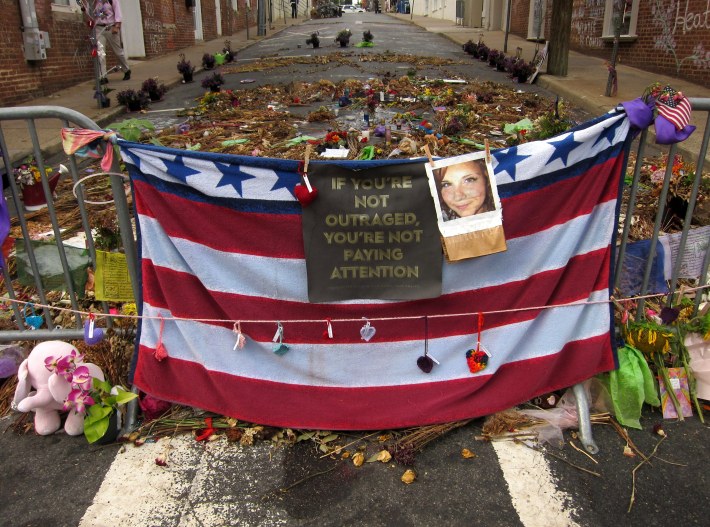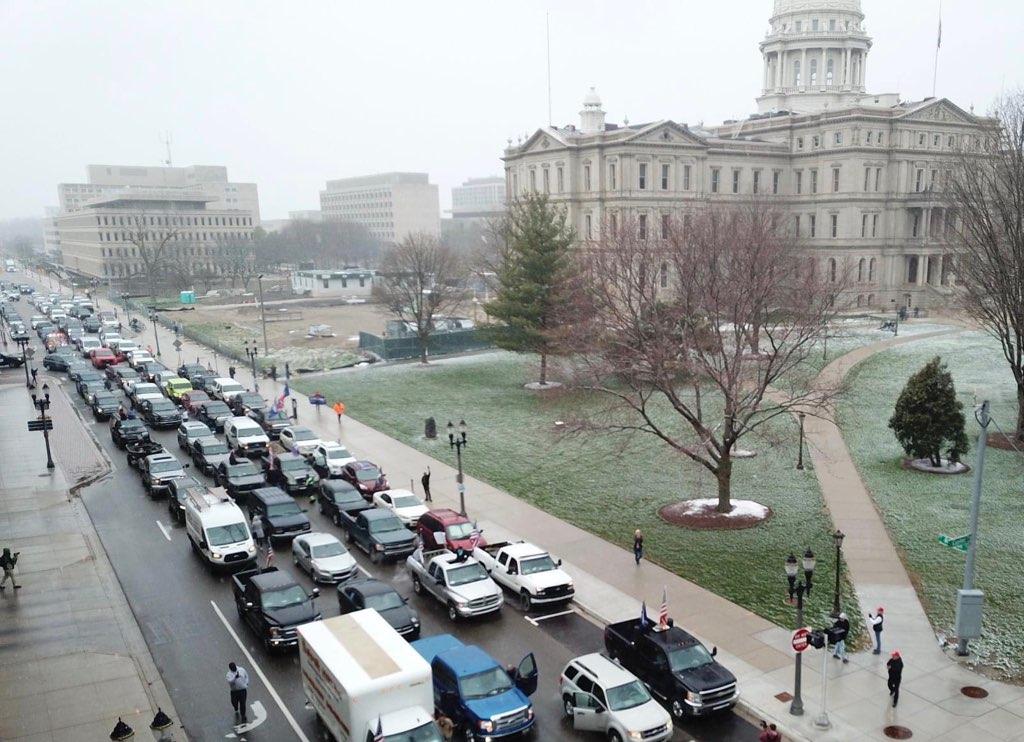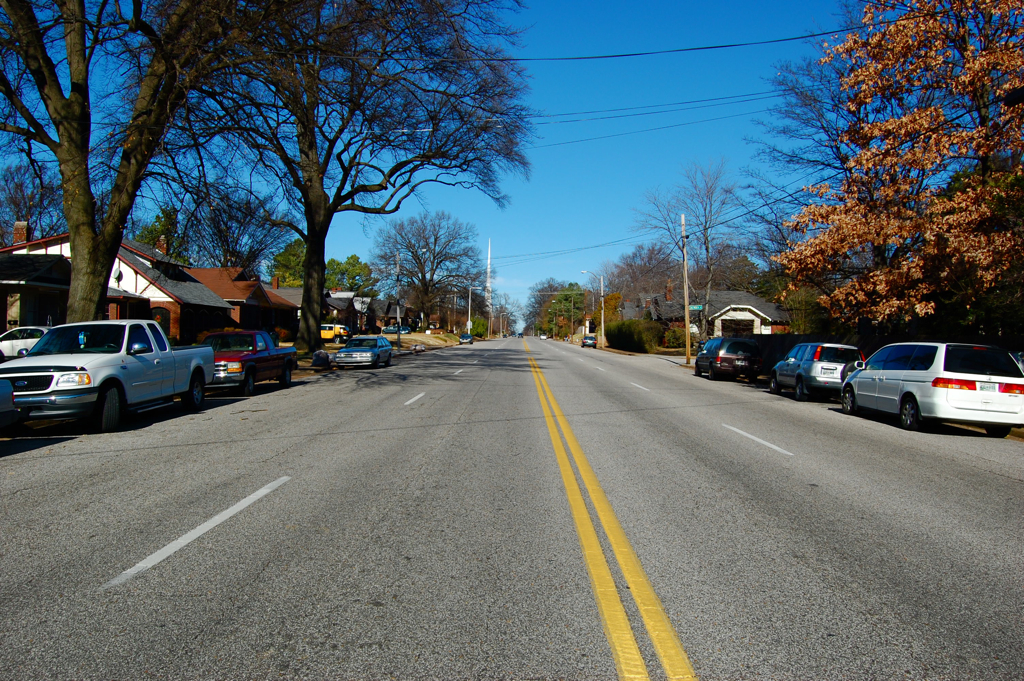What's the difference between a convoy of deadly cars and a peaceful public assembly?
It sounds like the set up to a bad joke. But as drivers turn to socially distanced "gridlock" protests to shut down American streets and grab their leaders' attention, we're all being forced to reckon with that question — and the question of how non-drivers can make themselves heard when one of the only ways to publicly protest without risking COVID-19 infection is from behind a windshield.
The most prominent "gridlock" protest to date happened on Wednesday, when swarms of self-described "conservative" drivers clogged the streets surrounding the Michigan capitol in Lansing to protest Gov. Gretchen Whitmer's extended statewide stay-at-home order. Waving semi-automatic rifles and Confederate battle flags out of car windows, the drivers' "demonstration" seemed less about exercising their right to peaceful protest and more about the theatrical intimidation of minority groups and government officials — and that intimidation graduated into an outright attack on public safety when cars blocked ambulances' access to a local hospital.
But there's one ingredient of the group's horrific intimidation tactics that didn't get nearly as much media attention as their assault rifles and racist regalia. It was their use of the car as a protest vehicle itself.
WATCH: Michigan Gov. Whitmer calls out demonstrators who protested stay-at-home order amid coronavirus pandemic https://t.co/6FK1yOX60V pic.twitter.com/icguccfYlq
— The Hill (@thehill) April 17, 2020
The motor vehicle, after all, has a long history of being deliberately used as a weapon by violent political insurgents, not to mention the 1.35-million-person body count every single year worldwide. Cars have become disturbingly normalized in American society, but they are indisputably deadly — and as anyone who remembers the murder of Heather Heyer knows, they can be and have been used by drivers to kill in a protest context.

But there's another, less bloody reason why the rise of the "gridlock" protest should trouble us: because they drown out non-drivers in one of the most important realms of the political process.
Whether they're protesting ICE detentions — yes, leftists and liberals do this car thing, too — or a ban on in-person Easter church services, people who protest from their cars monopolize scarce space in our civic discourse, as well as in our literal streetscape. No matter their political persuasion, they are choosing a protest tactic that is inherently inaccessible to non-driving supporters and inherently violent to society by its nature.
Let's be clear about something: the problem with "gridlock" protests isn't that the drivers who participate in them are restricting access to public space. Effective public assembly is crucial to our democracy, and it should make life inconvenient, especially for the powerful. It is essential that Americans of all political stripes continue to find creative and safe ways to demand the attention of the people who hold their fate in their hands during the era of social distancing.
But there's a world of difference between crowds of protestors demonstrating their people power at a statehouse sit-in, and the sheer horsepower of thousands of pick-ups idling in front of an emergency room entrance to make a point. When protest becomes dangerous to the lives of others — not dangerous to property, mind you, and certainly not dangerous to the status quo, but literally to the lives of our fellow man — it is no longer a peaceful demonstration.
Anyone who has a problem with protestors showing up to demonstrations armed with guns — as we should, especially when those guns are accompanied by flags printed with hate group symbols — should absolutely have a problem with protestors armed with 2,000 pounds of weaponizable steel and a gas pedal. Seen through that lens, bringing a car to protest at the steps of the statehouse isn't just bringing a gun to a knife fight: it's bringing a tank.
And, lest we forget: drivers already dominate our political landscape. Long before the era of the socially distanced "gridlock" protest, automobile interests have successfully won a disproportionate share of our transportation funding, almost complete legal immunity for drivers who kill and maim other road users in "accidents," and an outsized role in shaping our global culture.
In the era of social distancing, we should all demand that no one's voice is drowned out under the blare of car horns — and that means we need to get creative.
"The current street landscape in New York City has allowed conversations such as the inequitable distribution of street space to come to the forefront," said Erwin Figueroa, the director of organizing for Transportation Alternatives, an advocacy group that would never be able to mount a 300-car protest, but often loads up buses with hundreds of activists. "People not involved in advocating for car-free streets are even starting to question the amount of space dedicated to motor vehicles. This allows for more hyper-local, individual actions to take place: from measuring the width of their local sidewalks and documenting it to social media, to opening streets for pedestrians and cyclists with the help of neighbors and a couple of traffic cones, this is the time to tap into our collective creativity in advocating for more equitable streets."
We hope he's right — and we hope that the minivan doesn't become as big a fixture in our protest culture as the megaphone.






